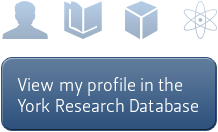Profile
Biography
I am a Reader in the Department of Mathematics at the University of York. Before that I was a Senior Lecturer in School of Mathematics, Statistics and Physics at Newcastle University and a Lecturer in the Department of Mathematics and Statistics at Lancaster University. My research interests lie in the area of mathematical statistics and machine learning. In particular, my field of research are kernel methods. More recently, I started working on applications of Abstract Wiener Spaces and Malliavin Calculus to Statistics and Machine Learning.
Career
My doctoral work comprised the development of a new Bayesian state-space modelling-based method, applied to the learning of the gravitational mass of the black hole in the centre of the Milky Way, and to the numerical modelling of non-linear dynamical phenomena in galaxies. Then following a Royal Society Dorothy Hodgkin Fellowship, I moved into methodology development within computational and mathematical statistics, while diversifying into applications in multiple disciplines besides Astronomy. Since early days, my work has often been Bayesian, and my go-to inferential technique is MCMC.
Research
Overview
I work on developing probabilistic methods that typically help towards mechanistic learning, and on the AI implementation of the same - given real-world information paradigms across disciplines. Currently, I am working on:
Fully non-parametric learning of the function that represents the relationship between a generic high-dimensional observable and system parameters, given messy real-world data. Applications of such methods have been made in Medicine; Astronomy; Materials Science, etc.
Learning random graphs given multivariate data, and computing a statistical distance/divergence between a pair of graphs that are learnt given the respective datasets that are generated under disparate conditions - to parametrise strength of difference between said conditions. Applications have been made to Oncology; Physiotherapy; protein design, etc.
Accurate forecasting by learning the function that causally links states attained by a (temporally-evolving) system at different times. Applications have been made to epidemiology and consumer price forecasting.
Estimating the “specification parameters” in a parametric model, while learning the unknown model parameters, given the available data on an associated observable. Application has been made to Astronomy.
Learning/estimation of uncertainty (or equivalently, the reliability), of tests and surveys.
Supervision
Researchers
Kane Warrior - gtq520@york.ac.uk
Publications
Selected publications
A New Reliable & Parsimonious Learning Strategy Comprising Two Layers of Gaussian Processes, to Address Inhomogeneous Empirical Correlation Structures
G Roy, D Chakrabarty
arXiv preprint arXiv:2404.12478
2024Reliable uncertainties of tests and surveys–a data-driven approach
SN Chakrabartty, W Kangrui, D Chakrabarty
International Journal of Metrology and Quality Engineering 15, 4
Constructing training set using distance between learnt graphical models of time series data on patient physiology, to predict disease scores
D Chakrabarty, K Wang, G Roy, A Bhojgaria, C Zhang, J Pavlu, ...
Plos one 18 (10), e0292404, 2024
Learning in the Absence of Training Data
Dalia Chakrabarty
PublisherSpringer International Publishing,
2024ISBN3031310136, 9783031310133
227 pages


.jpg)